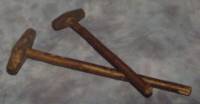
Stone Breaker's Hammers
These hammers were used by stone breakers to break road stones. The large hammer was used to break larger stones and the smaller one to break into an even size. These are not the original handles. The real handles would be made of ash so that there would be no sting going up the breaker's arms. The breakers broke piles of stones which were along the side of the road. They often held the stone under their toe as they hit it.
Road Making
Geoff Brennan told us that his father's steam engine was a convertible engine. It could be converted from the threshing engine into a steam roller. His father used to rent it to Kilkenny County Council, during the winter months for making roads. In those days, road making was very different to today. There was no tarmacadam. The surface of the road was made by steamrolling broken stones. The stones were made by being quarried and drawn by horse and cart. They were piled along the side of the road.
When the stones were being left along the side of the road, they were filled into boxes. These boxes were like large wooden crates with no bottom. They were filled level with the top and then the box was lifted up off the stones. This left the stones in a neat pile. The boxes were also important because the quarry men, car men and stone breakers were paid by the box. A box held a cubic yard of stones (a little more than a tonne). The breakers were paid one shilling (6c) per box.
Geoff said that it took a hard day's work to break 5 boxes. The stones were usually around November and December and were put out in lengths of about twenty yards. When Brennan's engine was working for the County Council, it also pulled a caravan and a water tank. The water tank was used for spraying the road. This helped to bed in the stones.
The engine driver stayed in the caravan during the week. It was a wooden caravan with solid wheels. It had two bunk beds and a stove. On winter evenings, local people would often come rambling to the caravan. They would sit around the warm stove chatting and telling stories. Geoff remembers about 1928 the County Council spent six weeks breaking stones in their yard. The stones were used to make a new road from Balleen Cross to Foyle Bridge. It was unusual for a whole stretch of road to be done at the same time. Roads were usually patched in short stretches.
Tony Coady told us that some patched of road would be very smooth and others would be full of sharp stones. Their bicycles were always getting punctures on the sharp stones.